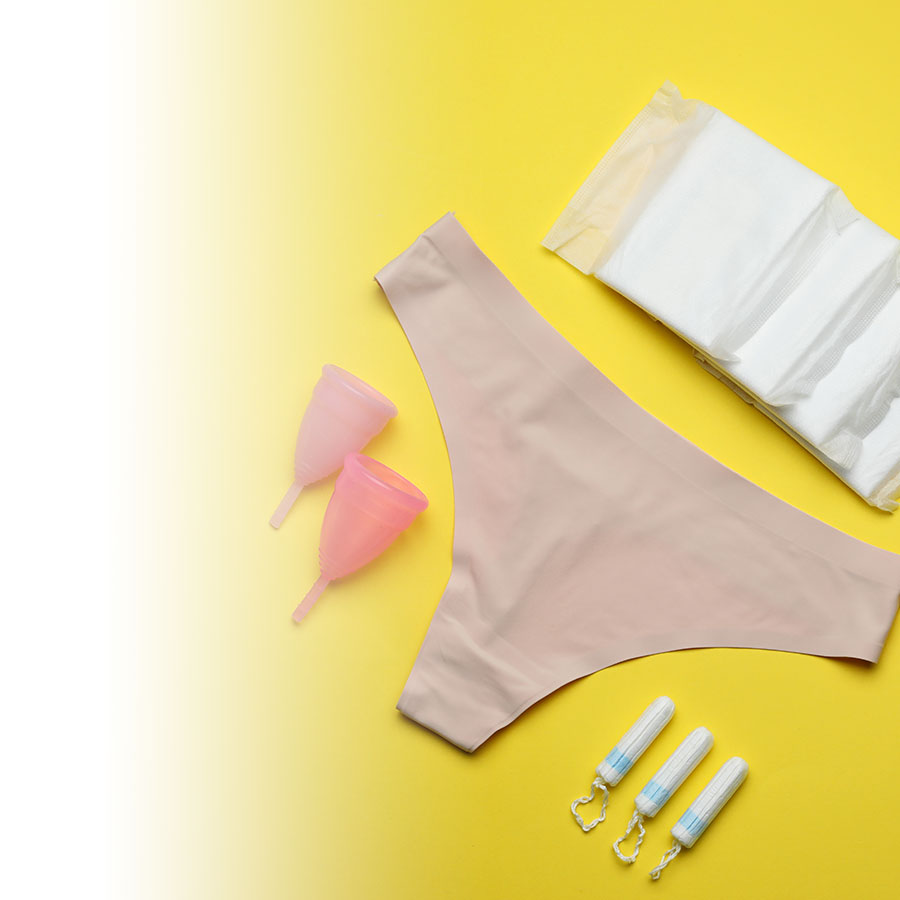Tampons, pads, panty liners, panties, menstrual cups, etc. What type of feminine hygiene protection should I choose during my period?
AN IMPORTANT CHOICE... THAT COMES BACK REGULARLY!
Feminine hygiene protection needs differ from person to person. With the right information, everyone can find the winning formula for comfort and peace of mind.
For some, menstruation is synonymous with leaks, unpleasant odours and embarrassing moments. Using the right feminine hygiene protection will minimize the risk of experiencing such inconveniences. Nowadays, there is a wide range of interesting and effective options to help you go about your day with peace of mind.
THE "CLASSIC" OPTIONS
Sanitary tampon
This small, disposable cylindrical device is both practical and discreet. It is inserted into the vagina, with or without an applicator, to absorb the flow of blood. It is especially useful for active people, including those who play sports or swim.
It must be changed regularly (every 4 to 8 hours), notably to reduce the risks of toxic shock syndrome (TSS), a serious health problem, with is fortunately very rare nowadays. Good habits (regular changes, hand washing before and after handling, choice of absorption level, removal at night, etc.) can minimize the risks.
There are many brands and models, varying in size and absorbency. For young girls, a light (narrower) tampon will often do the trick and introduce them to the process. During menstruation, the flow can vary, which is why it's a good idea to buy tampons with varying degrees of absorption: regular, plus, super or super plus, for example.
Menstrual pad
This is the basic hygienic protection. Very easy to use and to change, the sanitary napkin does not require any intravaginal manipulation. An adhesive strip keeps it in place inside the panties. It is changed when it has absorbed enough blood or as needed for comfort. It can be used during menstruation, as well as in other circumstances, such as after surgery or childbirth.
Models of various lengths, widths and features are available on the market. Some people like to have more than one model to meet their changing needs, depending on the time of day, the intensity of their period or other factors. The panty liner is smaller and less absorbent. It can be used in case of vaginal discharge or very light flow.
The main advantage of tampons and sanitary napkins is their convenience. However, they pose a threat to the environment because they cannot be reused. They generate enormous amounts of plastic waste and other non-biodegradable substances or materials on a global scale.
There are more and more eco-friendly options for those who want to reduce their environmental footprint.
ECO-FRIENDLY OPTIONS
Biodegradable and compostable protection
Many models of tampons and pads made of natural and compostable materials (e.g. organic cotton) are available. They do not contain any plastic or other materials that are harmful to the environment.
Washable menstrual pads and panties
These washable and reusable items provide effective absorbency, while minimizing the risk of leaks and ensuring comfort. They often come with a waterproof bag to store soiled pads or panties. Menstrual panties are extremely popular, thanks to their effectiveness and ease of use.
These options are economical and have undeniable ecological advantages. However, they require more work: they must be rinsed once soiled, then washed. Some women may not like the stains or feeling less "dry."
Menstrual cup
The menstrual cup is a small reusable bell-shaped container made of latex or silicone. It is inserted at the entrance of the vagina and collects the menstrual blood. It can hold up to one-third of the entire menstrual period's discharge without overflowing; however, it should not be worn for more than 12 hours. It is held in place by the muscles of the vagina.
It is considered the most economical and environmentally friendly option and has many other advantages: reduced risk of TSS, vaginal irritation or infection, no odour, comfort, ease of maintenance, etc.
For more information on intimate hygiene and menstrual protection, consult your pharmacist.


